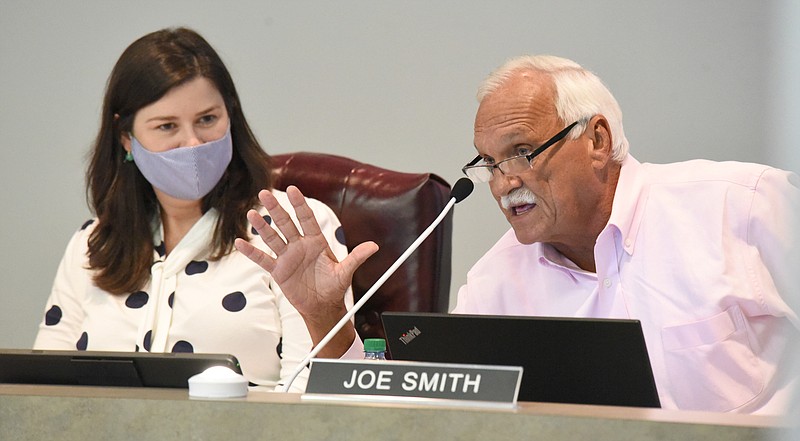Non-white students in Hamilton County Schools in the 2019-2020 school year made up a majority of the enrolled students for the first time, according to an interactive K-12 dashboard released earlier this week by the office of the Tennessee Comptroller of the Treasury.
The dashboard, which uses data from the Tennessee Department of Education's Annual Statistical Report, showed the population of white students fell to 49.54%, down from 58.43% in the 2012-2013 school year. The percentage of Black students also declined over the same period from 31.28% to 30.26%, while the Hispanic student population grew from 7.74% to 16.15%.
Despite those numbers, the number of economically disadvantaged students fell dramatically over the period, declining from 25,524 students in 2012-2013 - more than half of all students - to 14,705 - about a third of all students - in 2019-2020.
Those numbers indicate to us how strong the economy had been prior to the COVID-19 pandemic and how the economy's rising tide had lifted all demographics.
The dashboard showed that Hamilton County teachers and principals also benefited from the economy of the late 2010s, with classroom teachers realizing a combined 16.98% increase in their salaries from 2014 to 2020. The average classroom teacher salary jumped from $46,310 to $54,751, and the average principal salary increased from $85,033 to $102,651.
Of the four largest counties in the state, Hamilton County's teacher and principal salaries ranked third, behind those of Shelby County (Memphis) and Davidson County (Nashville) but ahead of Knox County (Knoxville). However, the salaries of Hamilton County's teachers and principals grew percentage-wise more than did those in any of the three other largest counties.
The combination of all education funds the state put into Hamilton County grew nearly $40 million over the period, going from $136.67 million in 2013 to $175.86 million in 2020. The Basic Education Program funds, meanwhile, did grow more than $40 million, moving from $128.49 million to $169.88 million.
Per-pupil expenditures for all state schools also were released recently, and the numbers bear out what we have said in this space recently about money not being the be-all, end-all solution for low-performing schools, as is often suggested by parents, activists and political organizations who have not done their homework.
Sequoyah High School, a vocational and technology school in Soddy-Daisy, had the district's highest total school per-pupil expenditure at $15,372.88 per its 262 students. Next was Chattanooga Girls Leadership Academy, a K-12 charter school, with $14,422.77 being expended per its 366 students.
Following those two were Orchard Knob Middle ($13,775.49), Chattanooga Preparatory School, a fairly new charter school ($13,739.38), and Howard Connect Academy ($13,660.87).
Rounding out the top 10 were Woodmore Elementary ($13,646.95), Lookout Valley Middle/High ($13,290.15), Tommie F. Brown Academy ($12,728.80), Hixson Elementary ($12,650.26) and Hillcrest Elementary ($12,626.14).
Of those, Brown Academy, Orchard Knob and Woodmore Elementary struggled on their 2021 TCAP tests, with proficiency falling off 5.2% in reading and 17.6% in math from 2019 at Brown Academy, for example, and improving at Woodmore but still only at 17% proficiency for reading and 19.1% proficiency for math.
The lowest per-pupil amounts were expended at Hamilton County Collegiate High at Chattanooga State ($6,253.07) and Hamilton County Virtual School ($6,263.51), neither of which are very large and neither of which have the expenses of a school with a traditional campus setting.
The rest of the five with the lowest per-pupil expenditures were Ivy Academy, a charter school ($8,964.57), Thrasher Elementary ($9,479.82) and Middle Valley Elementary ($9,536.96).
Thrasher, meanwhile, is one of the top performing elementaries with 77.3% of its students proficient in reading and 91.6% in math, while Middle Valley was slightly lower with 43.2% proficient in reading and 52.8% proficient in math.
Every year, around budget time for Hamilton County Schools, complaints are heard that the school district doesn't get its "fair share" from either the state or the county.
Indeed, two counties smaller than Hamilton (Montgomery and Rutherford) get more total money from the state, but where district-level per-pupil spending is concerned, Hamilton is third among the state's four largest counties. It trails Shelby and Davidson counties but is ahead of Knox County by more than a thousand dollars per student.
Figures don't tell the story at every school, but sometimes they provide context when emotional rhetoric seems to be the only speech of the day.
